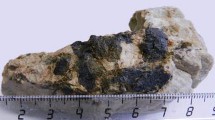Abstract
A new mineral, ferroindialite, a Fe2+-dominant analog of indialite, has been found in a pyrometamorphosed xenolith of pelitic rock hosted in alkaline basalts. Associated minerals are phlogopite, sanidine, sillimanite, pyroxenes of the enstatite-ferrosilite series, wagnerite, fluorapatite, tridymite, zircon and almandine. Ferroindialite forms brown-purple to gray with a violet-blue tint short prismatic or thick tabular hexagonal crystals up to 1.5 mm in size. The new mineral is brittle, with a Mohs’ hardness of 7. Cleavage is not observed. D meas = 2.66(1), D calc = 2.667 g/cm3. IR spectrum shows neither H2O nor OH groups. Ferroindialite is anomalously biaxial (−), α = 1.539(2), β = 1.552(2), γ = 1.554(2), 2V meas = 30(10)°. The mineral is weakly pleochroic, ranging from colorless on X to pale violet on Z. Dispersion is weak, r < v. The chemical composition (electron microprobe, mean of five point analyses, wt %) is as follows: 0.14 Na2O, 0.46 K2O, 4.95 MgO, 1.13 MnO, 12.66 FeO, 2.64 Fe2O3, 30.45 Al2O3, 47.22 SiO2, total is 99.65. The distribution of total iron content between Fe2+ and Fe3+ was carried out according to structural data. The empirical formula of ferroindialite is: (K0.06Na0.03)(Fe 2+1.12 Mg0.78Mn0.10)Σ2.00(Al3.79Fe 3+0.21 )Σ4.00Si4.98O18. The simplified formula is: (Fe2+,Mg)2Al4Si5O18. The crystal structure has been refined on a single crystal, R = 0.049. Ferroindialite is hexagonal, space group P6/mcc; a = 9.8759(3), c = 9.3102(3) Å, V = 786.40(3) Å3, Z = 2. The strongest lines in the X-ray powder diffraction pattern [d, Å (I, %) (hkl)] are: 8.59 (100) (100), 4.094 (27) (102), 3.390 (35) (112), 3.147 (19) (202), 3.055 (31) (211), 2.657 (12) (212), 1.695 (9) (224). The type specimen of ferroindialite is deposited in the Fersman Mineralogical Museum, Russian Academy of Sciences, Moscow, registration number 4400/1.
Similar content being viewed by others
References
Balassone, G., Franco, E., Mattia, C.A., and Puliti, R., Indialite in xenolithic rocks from Somma-Vesuvius volcano (Southern Italy): Crystal chemistry and petrogenetic features, Am. Mineral., 2004, vol. 89, pp. 1–6.
Fuchs, L.H., Occurrence of cordierite and aluminous orthoenstatite in the Allende meteorite, Am. Mineral., 1969, vol. 54, pp. 1645–1653.
Goldman, D.S. and Rossman, G.R., The site distribution of iron and anomalous biaxiality of osumilite, Am. Mineral., 1978, vol. 63, pp. 490–498.
Hochella, M.F.,Jr., Brown, G.E.,Jr., Ross, F.K., and Gibbs, G.V., High-temperature crystal chemistry of hydrous Mg- and Fe-cordierites, Am. Mineral., 1979, vol. 64, pp. 337–351.
Kitamura, M. and Hiroi, Y., Indialite from Unazuki pelitic schist, Japan, and its transition texture to cordierite, Contrib. Mineral. Petrol., 1982, vol. 80, pp. 110–116.
Meagher, E.P. and Gibbs, G.V., The polymorphism of cordierite: II. The crystal structure of indialite, Can. Mineral., 1977, vol. 15, pp. 43–49.
Mineraly. Spravochnik (Minerals. Reference Book), Chukhrov, F.V. and Smol’yaninova, N.N., Eds., Moscow: Nauka, 1981.
Miyashiro, A. and Iiyama, T., A preliminary note on a new mineral, indialite, polymorphic with cordierite, Proc. Japan Acad., 1954, vol. 30, pp. 746–751.
Miyashiro, A., Iiyama, T., Yamasaki, M., and Miyashiro, T., The polymorphism of cordierite and indialite, Am. J. Sci., 1955, vol. 253, pp. 185–208.
Petricek, V., Dušek, M., and Palatinus, L., Jana2006 Structure Determination Software Programs, Praha: Institute of Physics, Praha, 2006.
Ramesh Kumar, P.V. and Raju, K.K.V.S., Indialite for cordierite gneisses of Eastern Ghats Mobile Belt, India, Curr. Sci., 1997, vol. 73, pp. 382–385.
Schairer, J.F. and Yagi, K., The system FeO-Al2O3-SiO2, Am. J. Sci., 1952, Bowen vol., pp. 471–512.
Shtuckenberg, A., Punin, Yu.O., and Kahr, B., Optically Anomalous Crystals, Dordrecht: Springer, 2007.
Stanek, J. and Miskovsky, J., Sekaninaite, A new mineral of the cordierite series from Dolni Bory, Czechoslovakia, Scripta Facultatis Scientiarum Naturalium Universitatis Purkynianae Brunensis, Geologia, 1975, vol. 1, no. 5, pp. 21–30.
Witzke, T., Die Minerale der brennenden Halde der Steinkohlengrube “Deutschland-Schacht” in Oelsnitz bei Zwickau, Aufschluss, 1996, vol. 47, pp. 41–48.
Yoder, H.S., The MgO-Al2O3-SiO2-H2O system and the related metamorphic facies, Am. J. Sci., 1952, Bowen vol., pp. 569–627.
Author information
Authors and Affiliations
Corresponding author
Additional information
Original Russian Text © N.V. Chukanov, S.M. Aksenov, I.V. Pekov, B. Ternes, W. Schüller, D.I. Belakovskiy, K.V. Van, G. Blass, 2014, published in Zapiski Rossiiskogo Mineralogicheskogo Obshchestva, 2014, No. 1, pp. 46–56.
A new mineral species, ferroindialite, and its name considered by the Commission on New Minerals and Mineral Names, Russian Mineralogical Society and approved by the Commission on New Minerals, Nomenclature, and Classification of Minerals of the International Mineralogical Association, May 1, 2013, IMA no. 2013-016.
Rights and permissions
About this article
Cite this article
Chukanov, N.V., Aksenov, S.M., Pekov, I.V. et al. Ferroindialite (Fe2+,Mg)2Al4Si5O18, a new beryl-group mineral from the Eifel volcanic region, Germany. Geol. Ore Deposits 56, 637–643 (2014). https://doi.org/10.1134/S1075701514080029
Received:
Published:
Issue Date:
DOI: https://doi.org/10.1134/S1075701514080029




